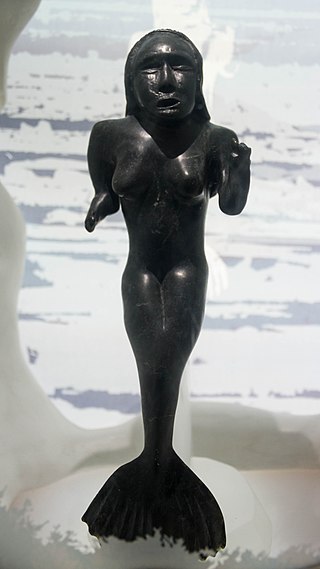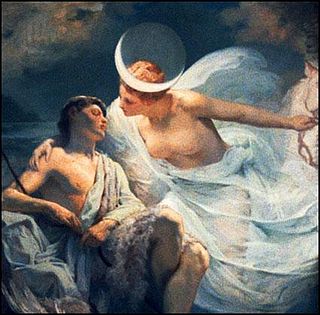This article needs additional citations for verification .(December 2009) |
In the Inuit religion, Alignak is a lunar deity and god of weather, water, tides, eclipses, and earthquakes. [1]
This article needs additional citations for verification .(December 2009) |
In the Inuit religion, Alignak is a lunar deity and god of weather, water, tides, eclipses, and earthquakes. [1]

Inuit religion is the shared spiritual beliefs and practices of the Inuit, an indigenous people from Alaska, northern Canada, parts of Siberia, and Greenland. Their religion shares many similarities with some Alaska Native religions. Traditional Inuit religious practices include animism and shamanism, in which spiritual healers mediate with spirits. Today many Inuit follow Christianity ; however, traditional Inuit spirituality continues as part of a living, oral tradition and part of contemporary Inuit society. Inuit who balance indigenous and Christian theology practice religious syncretism.
In Inuit religion, Nanook was the master of bears, meaning he decided if hunters deserved success in finding and hunting bears and punished violations of taboos. The word was popularized by Nanook of the North, the first feature-length documentary.
In Inuit mythology, Tarqiup Inua is a lunar deity.
In Inuit religion, Silap Inua or Sila is similar to mana or ether, the primary component of everything that exists; it is also the breath of life and the method of locomotion for any movement or change. Silla was believed to control everything that goes on in one's life.
Julana is a deity of the Jumu and Luritja people of Western Australia and the Northern Territory in Australia. In the mythology of the Jumu and Luritja people, Julana is an echerous spirit who surprises women by burrowing beneath the sand, leaping out, and raping them. When he was alive, he wandered the Earth with his father, Njirana, during the Dreamtime.

Iah (Egyptian: is a lunar deity in ancient Egyptian religion. The word jꜥḥ simply means "Moon". It is also transcribed as Yah, Jah, Aa, or Aah.
Finnish mythology commonly refers of the folklore of Finnish paganism, of which a modern revival is practiced by a small percentage of the Finnish people. It has many shared features with Estonian and other Finnic mythologies, but also with neighbouring Baltic, Slavic and, to a lesser extent, Norse mythologies.
Yarikh, or Yaraḫum, was a moon god worshiped in the Ancient Near East. He is best attested in sources from the Amorite city of Ugarit in the north of modern Syria, where he was one of the principal deities. His primary cult center was most likely Larugadu, located further east in the proximity of Ebla. His mythic cult center is Abiluma. He is also attested in other areas inhabited by Amorites, for example in Mari, but also in Mesopotamia as far east as Eshnunna. In the Ugaritic texts, Yarikh appears both in strictly religious context, in rituals and offering lists, and in narrative compositions. He is the main character in The Marriage of Nikkal and Yarikh, a myth possibly based on an earlier Hurrian composition. The eponymous goddess was regarded as his wife in Ugarit, but she is not attested in documents from most other Syrian cities, and most likely only entered the Ugaritic pantheon due to the influence of Hurrian religion.

The sky often has important religious significance. Many religions, both polytheistic and monotheistic, have deities associated with the sky.

The traditional Mayas generally assume the Moon to be female, and the Moon's perceived phases are accordingly conceived as the stages of a woman's life. The Maya moon goddess wields great influence in many areas. Being in the image of a woman, she is associated with sexuality and procreation, fertility and growth, not only of human beings, but also of the vegetation and the crops. Since growth can also cause all sorts of ailments, the moon goddess is also a goddess of disease. Everywhere in Mesoamerica, including the Mayan area, she is specifically associated with water, be it wells, rainfall, or the rainy season. In the codices, she has a terrestrial counterpart in goddess I.
Lithuanian Dievas, Latvian Dievs and Debestēvs ("Sky-Father"), Latgalian Dīvs, Old Prussian Diews, Yotvingian Deivas was the primordial supreme god in the Baltic mythology, one of the most important deities together with Perkūnas, and the brother of Potrimpo. He was the god of light, sky, prosperity, wealth, ruler of gods, and the creator of the universe. Dievas is a direct successor of the Proto-Indo-European supreme sky father god *Dyēus of the root *deiwo-. Its Proto-Baltic form was *Deivas.

A lunar deity or moon deity is a deity who represents the Moon, or an aspect of it. These deities can have a variety of functions and traditions depending upon the culture, but they are often related. Lunar deities and Moon worship can be found throughout most of recorded history in various forms.
Chuángshén is the Chinese deity of the bedchamber. It articulates in a couple of male and female deities: Chuángmǔ and her husband, Chuánggōng.

Dianmu, also known as Leizi, is the Chinese goddess of lightning, who is said to have used flashing mirrors to send bolts of lightning across the sky.